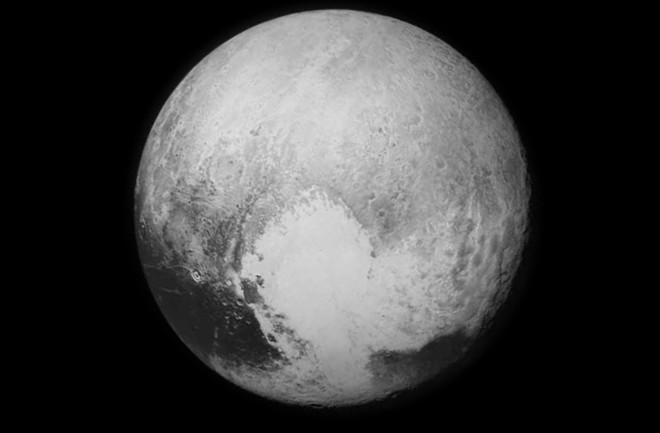1905: Beyond Neptune
Percival Lowell launches a search for "Planet X." His calculations are based on inaccurate contemporary estimates of Uranus' mass, but his quest will eventually turn up a different world.
February 18, 1930: Blink discovery
Clyde Tombaugh discovers Pluto from Lowell Observatory in Arizona by seeing it move on photographic plates over a six-day period.
1950: More to the story
Gerard Kuiper and others propose the existence of a large belt of icy objects beyond Neptune.
November 19, 1976: Methane measurement
Dale Cruikshank, Carl Pilcher, and David Morrison discover methane ice on Pluto, providing the first indication that the planet's surface is icy rather than rocky.
June 22, 1978: A Pluto companion
James Christy and Robert Harrington discover Pluto's largest moon, Charon. It appears as a slight elongation in these images of Pluto.
1985: Size matters
A series of mutual occultations between Pluto and Charon begins, allowing scientists to measure the objects' diameters and much more.
1987: Icy out there
Marc Buie and Robert Marcialis lead teams that discover water ice on Charon.
1988: Thin air
James Elliot and colleagues discover Pluto's thin atmosphere.
May 1, 1989: A call for exploration
About a dozen planetary scientists gather for dinner at a small Italian restaurant in downtown Baltimore. They call themselves the Pluto Underground, and the group decides to force the issue to get NASA on board with a mission to Pluto.
May 27, 1992: More and more icy
Toby Owen and colleagues discover nitrogen and carbon monoxide ices on Pluto.
August 30, 1992: No longer alone
David Jewitt and Jane Luu discover 1992 QB1, the first sighted partner to Pluto orbiting beyond Neptune, opening up a whole new realm of the solar system, that of the Kuiper Belt objects. Today, scientists know of more than 1,200 such trans-Neptunian objects.
March 8, 1996: Speckled surface
Using the Hubble Space Telescope, Alan Stern and colleagues create the first "world maps" of Pluto, showing color and brightness changes on the planet's surface.
November 29, 2001: Mission set
NASA selects the space probe New Horizons for a mission to Pluto.
May 15, 2005: More companions
Hal Weaver and Alan Stern lead a team that uses the Hubble Space Telescope to discover Pluto's moons Nix and Hydra.
January 19, 2006: Launch day
New Horizons launches from Cape Canaveral, Florida, to begin its nine-year, 3-billion-mile journey to Pluto.
August 24, 2006: Dwarf demotion
The International Astronomical Union redefines the term "planet," demoting Pluto to dwarf planet status and lumping it with Eris, a Kuiper Belt object similar in size to Pluto discovered in 2005.
February 28, 2007: Passing through
New Horizons flies past Jupiter, receiving a gravity assist that allows it to reach Pluto more quickly.
December 29, 2009: 1.5 billion miles down
New Horizons reaches its halfway point (in distance) to Pluto.
June 28, 2011: Party of five
Using the Hubble Space Telescope, Mark Showalter and colleagues discover Pluto's moon Kerberos.
July 7, 2012: Family of six
Using the Hubble Space Telescope, Mark Showalter and colleagues discover Pluto's moon Styx.
December 4, 2014: Go time
New Horizons awakens from hibernation and prepares for its Pluto flyby.
July 14, 2015: Hello Pluto!
New Horizons makes its closest approach to Pluto, flying some 7,700 miles from the planet's surface.
Read our latest coverage of the New Horizons mission here »

